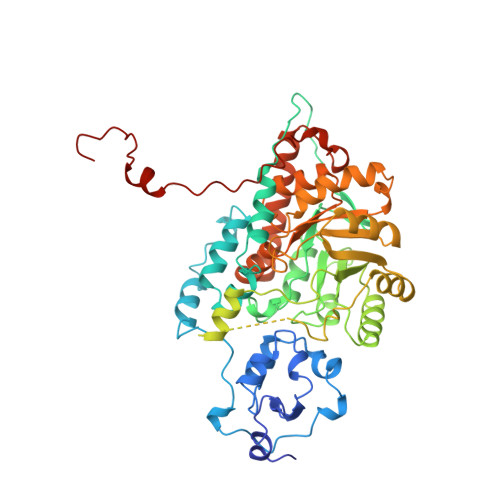X-ray structure of two complexes of the Y143F flavocytochrome b2 mutant crystallized in the presence of lactate or phenyl lactate.
Tegoni, M., Begotti, S., Cambillau, C.(1995) Biochemistry 34: 9840-9850
- PubMed: 7632684
- Primary Citation of Related Structures:
1LCO, 1LDC - PubMed Abstract:
Flavocytochrome b2 is a flavohemo enzyme localized in the intermembrane space of yeast mitochondria, where it catalyzes the electron transfer from its substrate, L-lactate, to cytochrome c. We have obtained crystals of a flavocytochrome b2 mutant, Y143F, which are isostructural with those of the native recombinant enzyme [Tegoni, M., & Cambillau, C. (1994) Protein Sci.3, 303-314]. These crystals were grown under similar conditions to those used to obtain the recombinant enzyme, but in the presence of phenyl lactate or lactate. We report here on the structural analysis of the two complexes of flavocytochrome b2 with the reaction products at 2.9 A resolution. In both structures, the Phe143 phenyl ring keeps the same position as that of the phenolic ring of Tyr143 in both the native recombinant and in the native wild-type enzymes. The product of the reaction, phenyl pyruvate or pyruvate, is present at the active site of both subunits, and not only in subunit 2 as observed in the wild-type structure [Xia, Z.-X., & Mathews, F.S. (1990) J. Mol. Biol. 212, 837-863]. The number of interactions between the FMN and the heme domain is considerably lower in the Y143F mutant than in the native proteins. The latter finding strongly supports the hypothesis that the main role of Tyr143 in the native proteins. The latter findings strongly supports the hypothesis that the main role of Tyr143 in the native protein probably consists in establishing a hydrogen bond with the heme [Xia, Z.-X., & Mathews, F.S. (1990) J. Mol. Biol. 212, 837-863]. This interaction appears to be essential for the two domains to approach each other suitably so that the intramolecular electron transfer can occur.
Organizational Affiliation:
Laboratoire de Cristallographie et Cristallisation des Macromolécules Biologiques, URA-1296 CNRS, Marseille, France.

















